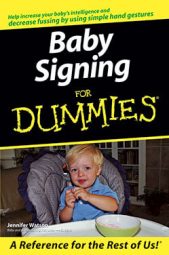Sign language for babies is a method of using either invented hand gestures or American Sign Language (ASL) to communicate with very young children months — and even years — before they can communicate verbally. (American Sign Language is the official name of the official sign language for the deaf.)
The reason babies don't speak isn't for lack of understanding. It's for lack of the ability to control the movements of the mouth and tongue that are necessary to produce intelligible, audible speech. Those movements are undeveloped until babies are older. However, at a much earlier age, babies can control the movements necessary to produce signs. And as a result of this ability, a world of two-way communication can be opened for babies and their caregivers.
Signing with babies provides many benefits. Consider these, for example:
- Signing gives babies a voice by giving them a way to communicate their wants, needs, and observations. Instead of simply trying to guess what a crying baby needs, for example, a parent or caregiver can understand the need because the baby signs MILK or BALL or FINISHED. Of course, this doesn't mean the crying stops altogether, but frustration levels are drastically reduced because — through the signs that the baby can make — he can communicate some of his specific wants, needs, and observations.
- Research shows that by the time children who signed as babies and toddlers are in second grade, their IQ scores are an average of 12 points higher than the IQ scores of their non-signing peers. So, beyond the immediate benefits of giving babies a voice and reducing frustration levels, signing has long-term benefits as well.
- Speech stimulates a particular part of a person's brain. Children who have chatty, interactive parents typically have more stimulation in the speech center of their brains. Furthermore, children who are exposed to a secondary language have stimulation in an additional part of their brains as they're exposed to and learn the language.
- Signing a word makes that word more concrete. The child is not only hearing the word but also seeing the sign for the word, seeing the object of the sign, and feeling the movement of the sign. Repeatedly experiencing the sign will eventually lead to a child's responding to the sign through obvious understanding or using the sign or word itself.
Some folks worry that signing might delay their babies' speech. Rest assured, research has repeatedly proven that signing children actually begin to speak earlier and speak more often than their non-signing counterparts.

